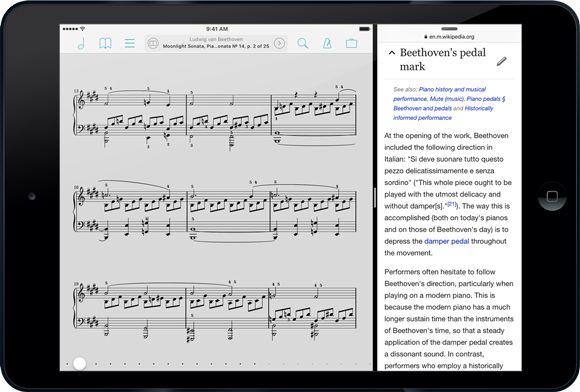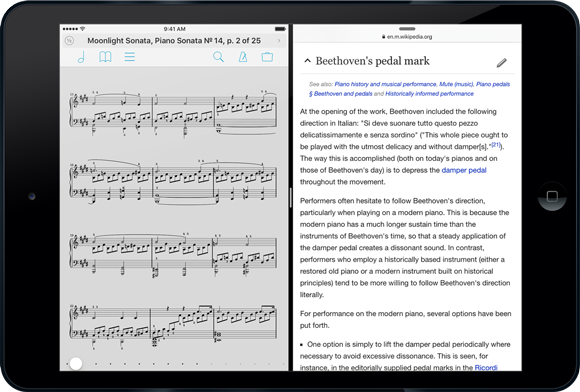
September 25, 2015
Feature of the Week
Last year’s iPad upgrades got a mixed reception, largely due to the similarity between the iPad mini 2 and the then-new iPad mini 3. It turns out that there was a little more to the story though. The iPad Air 2, a decent upgrade as presented, actually includes one technical change that’s only now being put to use: Apple has doubled the amount of data the screen can collect from your touches.
Every iOS device refreshes its screen sixty times per second. In fact, a lot of system processes are tied to that number, so it was natural to put touch handling in that queue as well. The problem is, when you draw with your finger on a screen that’s collecting sixty points per second, your movements don’t always turn out the way they should. Sixty seems like a lot, but when you’re moving quickly some details get lost.
With the iPad Air 2, Apple doubled the sample rate to 120 points per second. It’s just that no one knew about it, because developers didn’t have access to this additional information until iOS 9’s release last week. All of the pieces had to fall into place, but now they’re here: with an iPad Air 2, running iOS 9 and forScore 9.1, your drawings will be more accurate and feel more natural.
Even if you don’t have the latest iPad, though, you can still benefit from another improvement made in iOS 9 called Predictive Touches. As the name implies, Apple’s new OS gives developers a best guess about where your finger or stylus is headed. That helps us draw the results sooner, making your drawing experience feel more responsive. And, best of all, the predicted touches are only temporary—they’re replaced by actual touches as soon as possible so your drawing accuracy doesn’t suffer.
They’re not big, banner-worthy features and they don’t really have a catchphrase, but iOS 9’s drawing improvements add up for users like our customers who rely on quick, natural annotation.
Today’s release of iOS 9 means some of you will just be getting started with new iPad multitasking modes, Split View and Slide Over. So what are they? How do they work? What silly things can you do with them? Keep reading this special Wednesday edition of Feature of the Week and you’ll soon be a pro, ready to impress your colleagues and show them how it’s done:
Slide Over
The first new multitasking mode for iOS 9 is Slide Over, a feature that lets you temporarily bring another app into view over the current app from the right-hand side of your screen. While viewing an app, just slide your finger from the right edge of the screen into the middle. You’ll see a vertical list of icons for the apps that support Slide Over, and you can tap on one to open it. This lets you do something quick like respond to a message or check a web page without closing the current app first. The main app will dim and won’t be interactive while you’re working with the second app, but you can swipe from left to right or tap on the dimmed app to dismiss the second app and continue what you were doing.

Once you’ve picked an app it’ll be the one you see each time you use Slide Over (unless iOS closes it to free up memory), but you can swipe down from the top of the screen within the Slide Over area to choose another app to use here. Apps must be updated to support Slide Over, so the list of available apps may be limited until more developers get on board. On the other hand, developers must specifically opt out of support for being the primary (dimmed) app, so you should be able to activate Slide Over from within most apps.
Slide over is compatible with iPad Air or newer, iPad mini 2 or newer, and the new iPad Pro (once it’s released this fall).
Split View
If you’re using an iPad Air 2, the brand new iPad mini 4, or once you get your hands on the upcoming iPad Pro, you’ll also be able to use Split View. With Split View you can run two apps side-by-side and work with them simultaneously. Unlike Slide Over, neither app is dimmed or inactive, so you can use them like you normally would. To use Split View, swipe from the right just like you do with Slide Over, then enlarge the window by dragging its left edge into the center of the screen. Your two apps will blur and display their icon until you let go, settling in to their respective sides of the screen.

You get a little bit of control over how much space each app takes up on the screen, but only in landscape orientation. In portrait, the app on the right gets the classic iPhone width of 320 pixels, while the app on the left gets the rest. In landscape mode, you can choose one of two options: the same 320 pixels on the right and the remaining space on the left, or a 50/50 split. Just drag the divider left or right to change which option you’re using.

When you need to focus on one app or the other, just drag that dividing line all the way to the left or right, depending on which app you want to keep. The other will be closed just like it normally does when you press the home button.
Speaking of the home button, if you press it while working in split view, iOS will close both apps but remember which one was on the right and use it in combination with whatever app you open next.
Side Effects
As it so happens, there are a few things you can do that are probably useless but fun to try anyway. First, if you’ve downloaded today’s update to forScore Cue, you can use Split View to see forScore on one side of the screen while controlling it from Cue on the other. You can also activate Console in forScore and use Safari at the same time to edit your library (it doesn’t work well—we’ve never needed to optimize the Console web editor for a mobile device, so be warned).
So now you’re a pro at multitasking on iPad with iOS 9 and forScore 9.1. Tell your friends!
iOS 9 is coming tomorrow, so many of you are wondering if forScore will work properly if you choose to update. Although there were some major bugs with early beta versions of iOS 9, Apple has since fixed them and we are happy to report that we’re not aware of any compatibility issues with the current versions of forScore and forScore mini.
Of course, if you’re itching to install iOS 9 you’re probably anxious to try out all of the new features, so today we’re proud to announce the immediate availability of forScore 9.1 and forScore mini 2.1.
With forScore 9.1, you’ll be able to take advantage of iOS 9’s new Split View and Slide Over multitasking modes, an improved drawing experience (especially if you’re using an iPad Air 2), and some clever keyboard enhancements. Of course, we already did most of the work required to support these new features earlier this summer with forScore 9, so it’s exciting to be able to finally show it all off.
Both forScore 9.1 and forScore mini 2.1 include a few bug fixes and improvements like a more flexible tuning option for the pitch pipe’s tone generator, so even if you’re sticking with iOS 8 for now there’s something for everyone.
As always, these updates are completely free for existing users, so be sure to check out forScore 9.1 and forScore mini 2.1 today!
September 11, 2015
Feature of the Week
The Setlists tool is one of the most important features of forScore, and when you’re playing in a group you need to make sure everyone is on the same page. From the first view of the Setlists menu, tap “Edit” and select one of your setlists, then tap “Share” to see a long list of options. Here’s what each of them does:
Text List
If you’re working with colleagues who don’t have forScore, a text list might be the easiest way to go. It provides a numbered list of each of the titles in your setlist so others can re-create it on their own device or with good old fashioned paper.
Setlist Only
When your colleagues use forScore, sharing setlists with them is a lot simpler. Just choose this option to send a forScore-specific .4SS file to them and their copy of forScore will attempt to match up the titles in your setlist with files they already have. It’s an extremely lightweight way to share a setlist if you know that someone already has all of the PDFs they’ll need.
Include Scores
If you’re not sure that your colleague has all of the PDFs in your setlist, you can share a .4SS file just like the previous option but with all of its items included as well. Scores are sent as-is, and bookmarks are exported first so you’ll only be sending the necessary pages.
Include Scores & Extras
Like the previous option, this will send a .4SS file to your fellow forScore user(s) with all of its items included. Additionally, each item will include extra information like editable annotations, metadata, and more.
Merged PDF
Another simple option is to create one long PDF file that contains all of your setlist’s items in order. It’s a simple way to share a setlist with your forScore friends without adding a bunch of new files to their library, and it’s also a great way to share a setlist with anyone using a different app or device.
Annotated Merged PDF
Just like the previous option, but with annotations hard-coded onto each page. These annotations cannot be changed, even by forScore users, but they’ll look similar in other apps, on other devices, or printed out on paper.
That’s a lot of different ways to share a setlist, and people use every single one of them! Once you’ve picked an option, you’ll be able to send your setlist via email, AirDrop it to nearby iOS devices or Macs, or open it in another app. And don’t forget, you can always use the Services panel to upload a 4SS file to your Dropbox, Box, or other cloud account. So next time everyone is scrambling to rearrange their songs, save them some time and effort!
Apple’s announcements today have finally put an end to the years of speculation: an iPad Pro is coming later this year. Many people have already contacted us wondering if we’ll be supporting it and the answer is an absolute yes.
In fact, forScore seems to work pretty much as-is thanks to the changes we’ve already made to support iOS 9’s new multitasking modes. Here’s a screenshot:

We’re just getting started with the iOS 9.1 beta that’ll be required to support the iPad Pro when it’s released this November, so we don’t any final information at this point, but it’s looking great so far. We also don’t have any information regarding the new Apple Pencil, but we fully expect to be able to support it and the new keyboard accessory later this year. As with most things, we just can’t guarantee anything until we have these new devices in hand.
Until then, we’ll be putting the final touches on forScore 9.1, forScore Cue 1.3, and TuneWave 1.1 all with support for iOS 9’s Slide Over and Split Screen multitasking modes. One thing is for certain: it’s going to be a busy fall!



